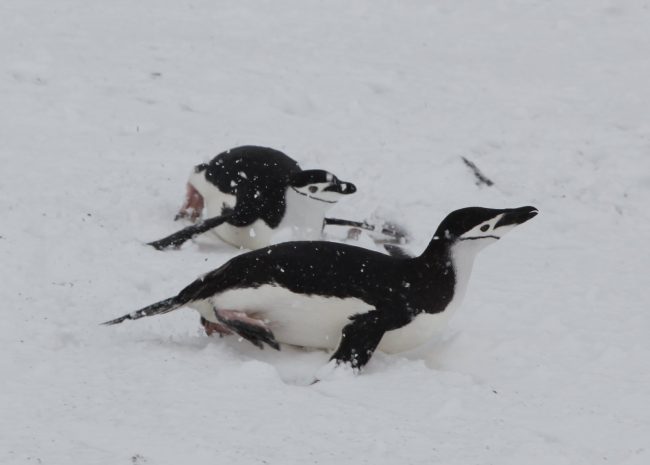Generally, birds have two types of movement one is flying using wings, and one more is walking with their feet. But penguins are flightless birds, so they don’t operate in the sky; instead, they ‘fly’ underwater using wings called flippers. They also walk on land with short steps using feet carrying a fat body. Penguins have one more habit of movement – called tobogganing.

What is this tobogganing?
Penguins lay their bodies on ice and slide over the ice using the flippers and feet to move forward themselves; this process is termed to be tobogganing. Tobogganing is a type of movement that penguins have adapted to move quickly to cross a large area of ice with less time compared to walking. This adaptation provides faster, easier, and efficient movement for penguins to reach their destination.
Why do penguins adapt tobogganing?
Penguins adopted many unique properties compared to other birds. Penguins have short, sharp, thick-skinned legs as well as webbed feet with visible claws. Their legs are set far back on the body, which helps to stand in an upright position. Penguins are excellent and fast swimmers underwater, whereas, on the land, their walking speed is too slow.
Penguins choose to toboggan to cover a large area of travel. Tobogganing speed is many times more compared to the rate of walking. Some of them may confuse and compare the tobogganing to swimming, flying, and falling, but they are not. It is just an adaptation. Tobogganing is also known as ‘sledding,’ ‘sliding,’ etc.
Tobogganing provides advantages like,
- It provides benefits for penguins to protect themselves from predators like seals on the ice.
- It also helps to escape quickly from unknown organisms like humans or research, etc.
- Through walking, they can cover only two miles per hour, but by tobogganing, they cover a large area several times more than walking.
Tobogganing provides disadvantages like,
- Penguin tobogganing adaptation gives more worn for the plumage (feathers), which may result in damage.
- It also affects the insulating property of the plumage and increase in feather wear.
- If tobogganing is in practice often, then penguins have to maintain a significant amount of time in preening (cleaning of feathers by a beak) to keep their plumage in healthy condition.
Penguins have some right conditions for tobogganing. The snow must be soft so that they can slide over. If the snow is deep, they toboggan slowly, and even when they are not in a hurry, the speed gets slow. When they slide or lay on the ice, their bodyweight spread over a wide area, and they do not get submerged into the snow as far as compared to when they are on the feet.
So this gives an efficient, effortless, energy-saving, and faster mode of transport. Even penguins white bellies help them to slide over the ice and as well as for self-protection, which means it makes invisible for predators so they can escape from the threat.
Conclusion
Tobogganing is the third way of transport for the penguins, adapted to move quickly by laying their body on the ice and sliding over the ice. Their waddling doesn’t help much as compared to tobogganing. Tobogganing has advantages as well as disadvantages too, as explained above. When they are tired of walking, they start to slide over the soft snow, pushing themselves using flippers, and feet.
Reference:
https://www.thespruce.com/glossary-definition-of-tobogganing-385398
https://sciencing.com/penguins-move-4567706.html